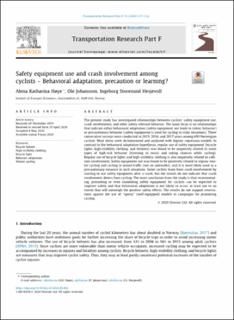| dc.contributor.author | Høye, Alena | |
| dc.contributor.author | Johansson, Ole Jørgen | |
| dc.contributor.author | Hesjevoll, Ingeborg Storesund | |
| dc.coverage.spatial | Norway | en_US |
| dc.date.accessioned | 2021-07-13T11:29:00Z | |
| dc.date.available | 2021-07-13T11:29:00Z | |
| dc.date.created | 2020-07-21T12:43:41Z | |
| dc.date.issued | 2020-06-09 | |
| dc.identifier.citation | Transportation Research Part F: Traffic Psychology and Behaviour. 2020, 72 (July), 117-132. | en_US |
| dc.identifier.issn | 1369-8478 | |
| dc.identifier.uri | https://hdl.handle.net/11250/2764276 | |
| dc.description.abstract | The present study has investigated relationships between cyclists’ safety equipment use, crash involvement, and other safety relevant behavior. The main focus is on relationships that indicate either behavioral adaptation (safety equipment use leads to riskier behavior) or precautionary behavior (safety equipment is used for cycling in risky situations). Three consecutive surveys were conducted in 2015, 2016, and 2017 years among 650 Norwegian cyclists. Most items were dichotomized and analyzed with logistic regression models. In contrast to the behavioral adaptation hypothesis, regular use of safety equipment (bicycle lights, high-visibility clothing, and helmets) was found to be negatively related to some types of high-risk behavior (listening to music and taking chances while cycling). Regular use of bicycle lights and high-visibility clothing is also negatively related to collision involvement. Safety equipment use was found to be positively related to regular winter cycling and cycling in mixed traffic (not on sidewalks), and it is most likely used as a precautionary measure in such situations. Some cyclists learn from crash involvement by starting to use safety equipment after a crash, but the results do not indicate that crash involvement deters from cycling. The main conclusion from the study is that recommending, promoting or even mandating safety equipment for cyclists can be expected to improve safety and that behavioral adaptation is not likely to occur, at least not to an extent that will outweigh the positive safety effects. The results do not support reservations against the use of “sporty” (well-equipped) models in campaigns for promoting cycling. | en_US |
| dc.language.iso | eng | en_US |
| dc.publisher | Elsevier | en_US |
| dc.rights | Navngivelse 4.0 Internasjonal | * |
| dc.rights | Navngivelse 4.0 Internasjonal | * |
| dc.rights.uri | http://creativecommons.org/licenses/by/4.0/deed.no | * |
| dc.title | Safety equipment use and crash involvement among cyclists – Behavioral adaptation, precaution or learning? | en_US |
| dc.type | Peer reviewed | en_US |
| dc.type | Journal article | en_US |
| dc.rights.holder | © 2020 Elsevier Ltd. All rights reserved. | en_US |
| dc.description.version | publishedVersion | en_US |
| cristin.ispublished | true | |
| cristin.fulltext | preprint | |
| cristin.qualitycode | 1 | |
| dc.identifier.doi | 10.1016/j.trf.2020.05.002 | |
| dc.identifier.cristin | 1820025 | |
| dc.source.journal | Transportation Research Part F: Traffic Psychology and Behaviour | en_US |
| dc.source.volume | 72 | en_US |
| dc.source.issue | July | en_US |
| dc.source.pagenumber | 117-132 | en_US |

